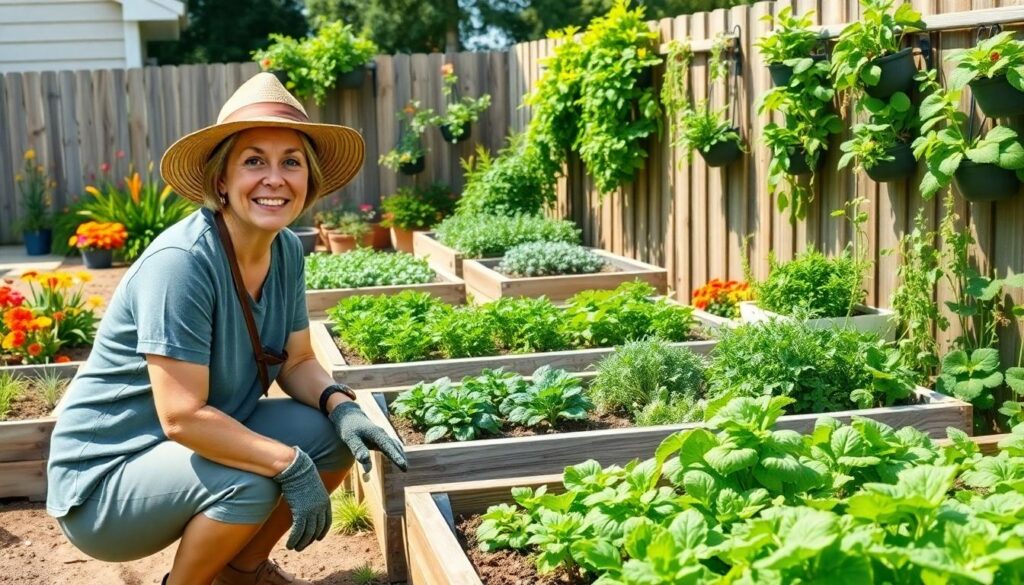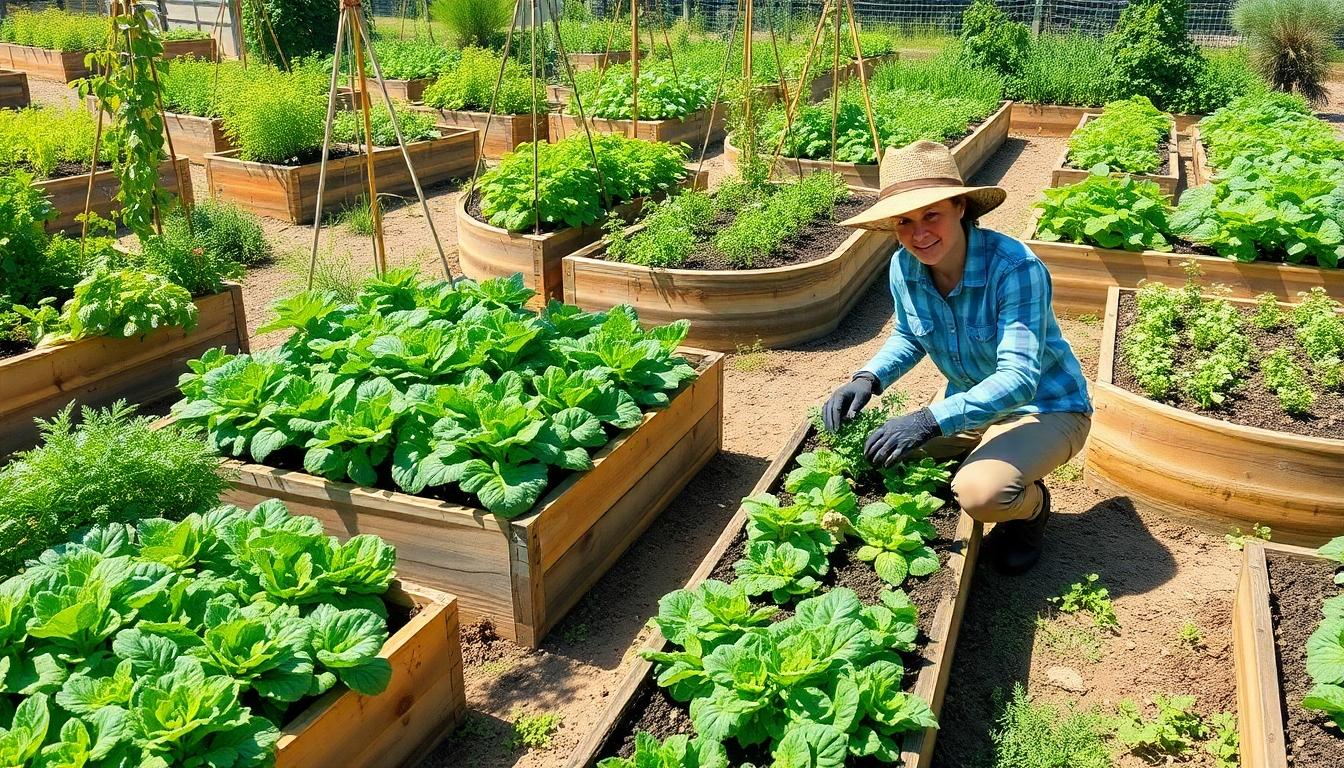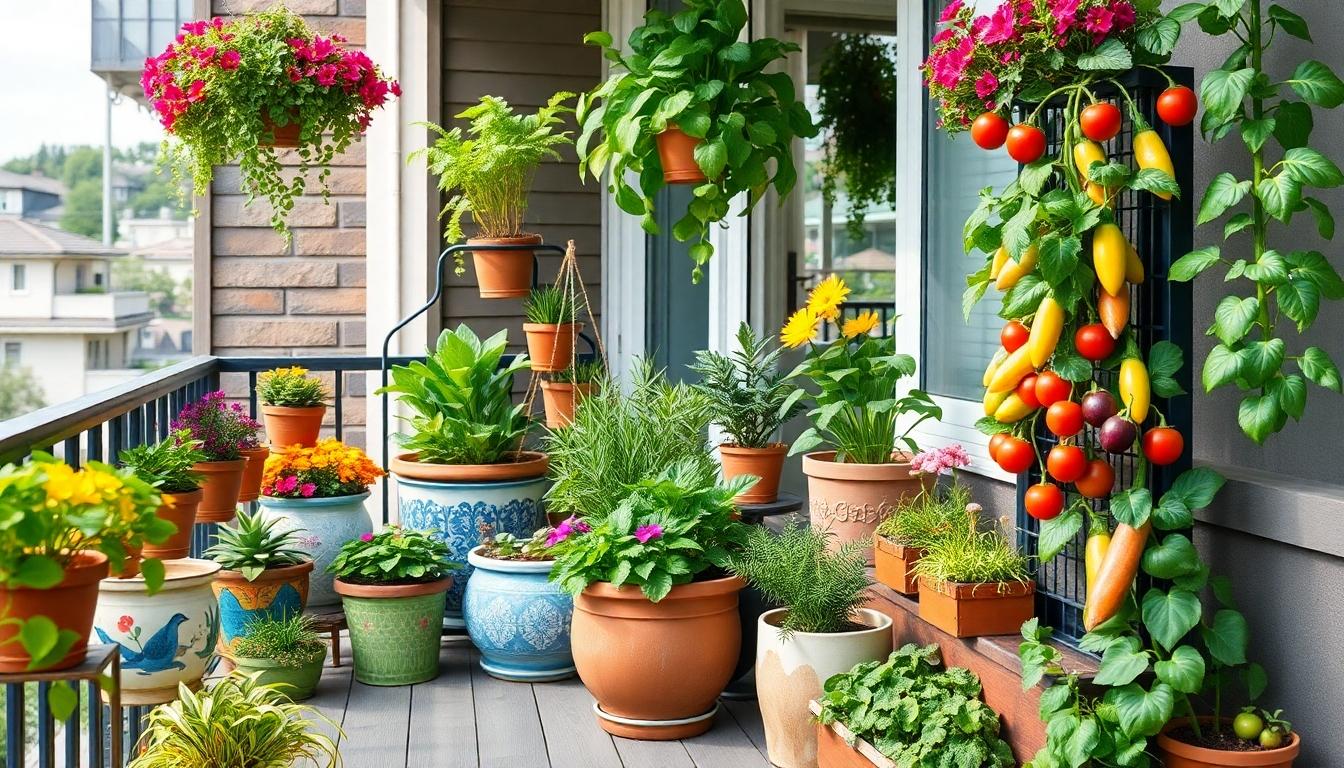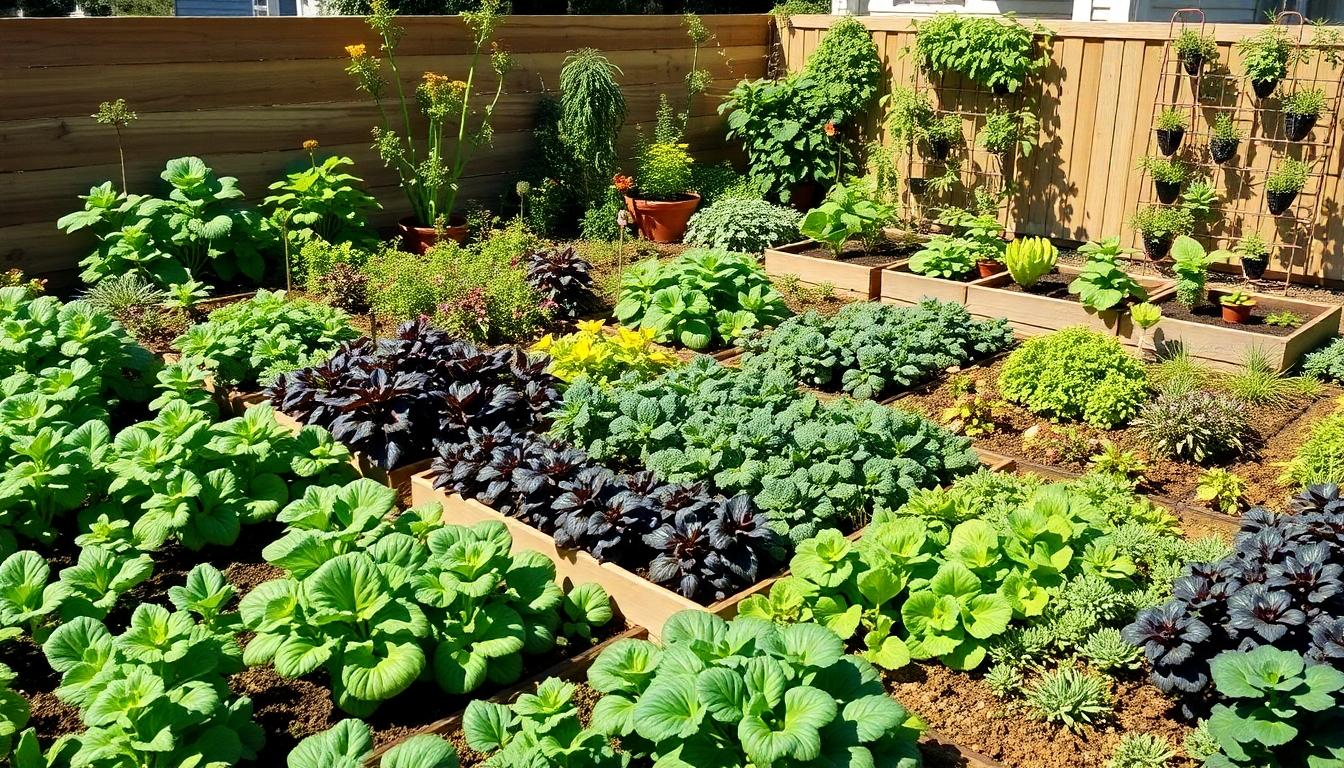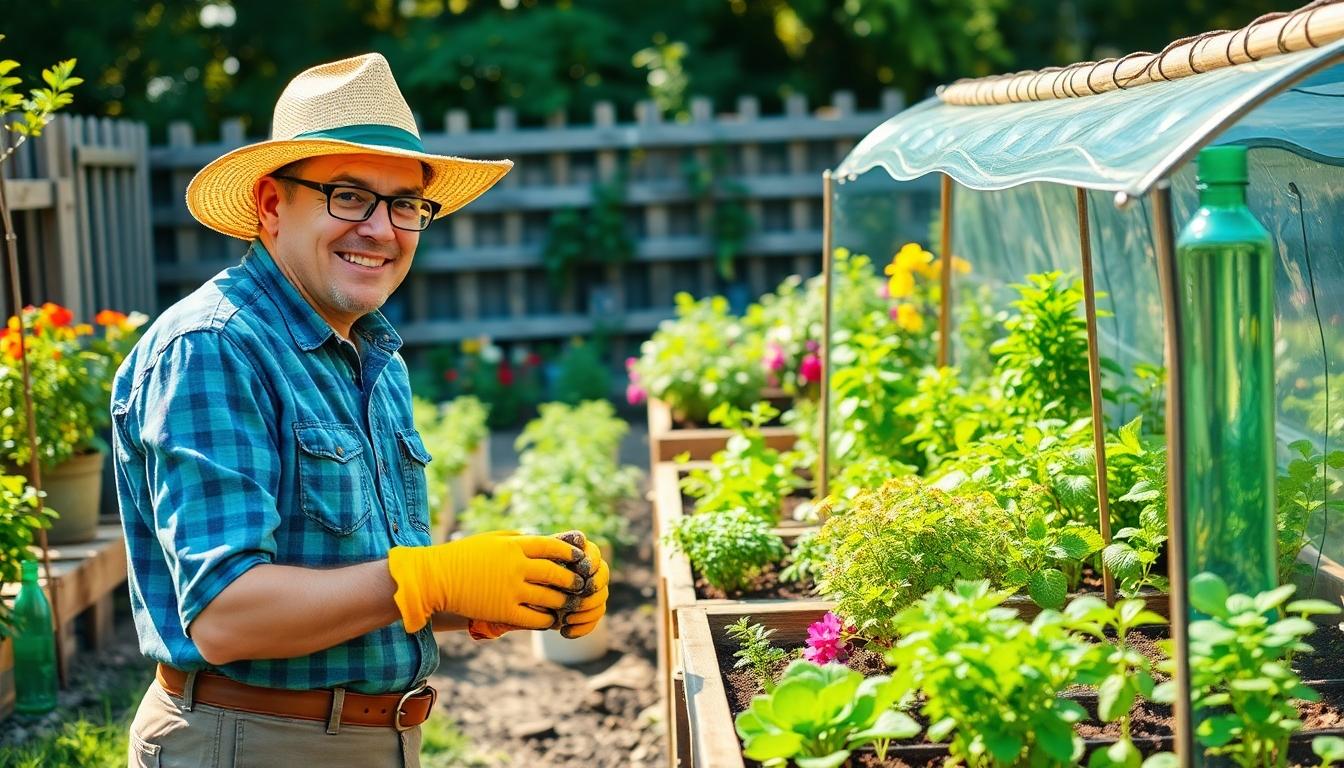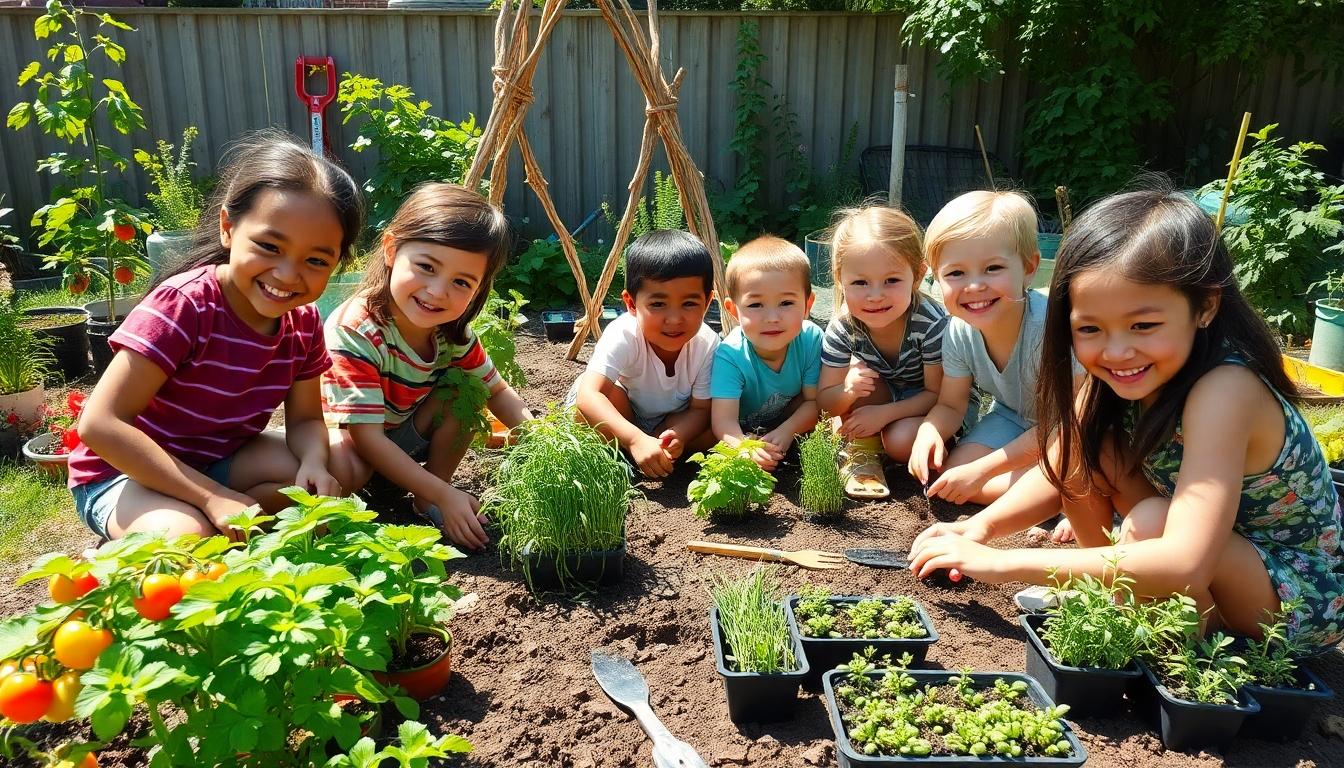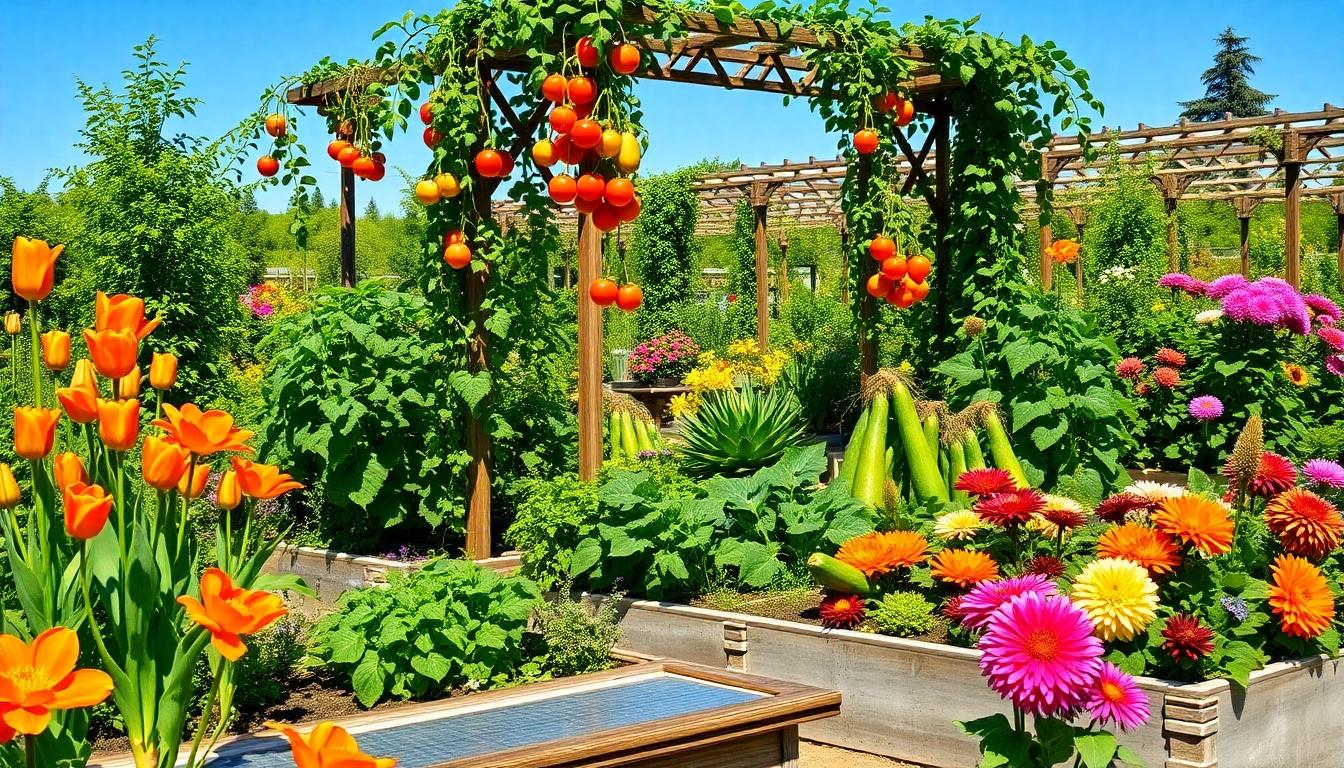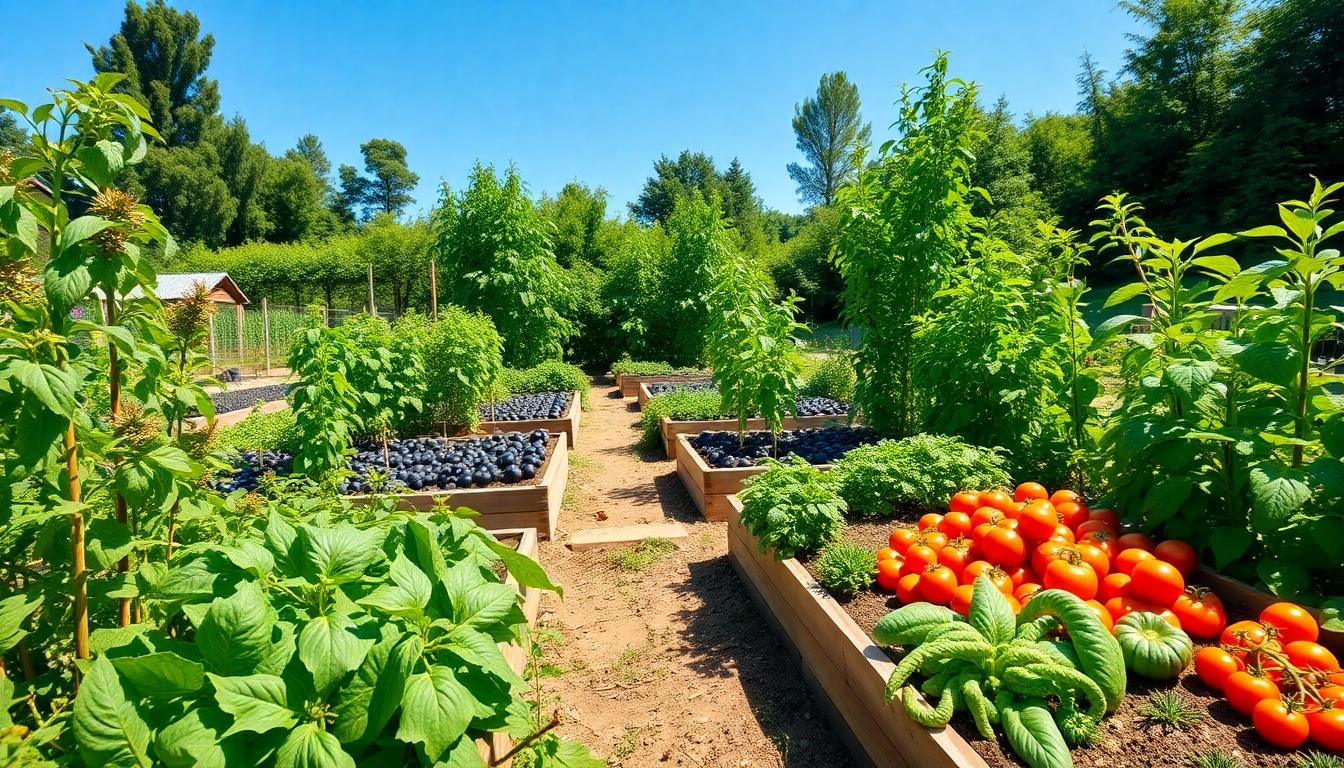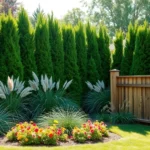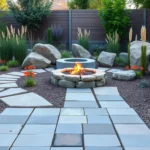Looking to transform your backyard into a thriving vegetable paradise? We’ve gathered the most inspiring vegetable garden ideas to help you create a beautiful and productive growing space, no matter how much room you have to work with.
From vertical gardens that maximize small spaces to raised beds that make harvesting easier, there’s something for every gardener in our collection. We’ll show you how clever planning and creative design can turn even the smallest patch of soil into a bountiful source of fresh, homegrown produce that’ll have your neighbors green with envy.
10 Space-Saving Vertical Vegetable Garden Ideas
Limited gardening space doesn’t mean limiting your vegetable growing dreams. Vertical gardening maximizes productivity while minimizing footprint, perfect for urban dwellers and those with small yards.
Pallet Wall Gardens for Herbs and Greens
Upcycled wooden pallets create outstanding vertical gardens that maximize growing space for herbs and leafy greens. Securing a pallet to a sunny wall transforms unused vertical space into a productive growing area with multiple planting pockets. Shallow-rooted plants like basil, cilantro, lettuce, spinach, and arugula thrive in these systems. Line each slat opening with industry fabric before adding soil to prevent erosion while allowing proper drainage. Position sun-loving herbs at the top rows and shade-tolerant greens toward the bottom for optimal growing conditions. Watering requires careful attention since top plants may receive more moisture than lower ones.
Hanging Basket Arrangements for Cherry Tomatoes
Cherry tomatoes flourish in hanging baskets, producing cascading vines that add both beauty and function to vertical spaces. Select compact or determinate varieties specifically bred for container growing like ‘Tumbling Tom,’ ‘Tiny Tim,’ or ‘Balcony Cherry’ for best results. Install sturdy hooks from pergolas, eaves, or shepherd’s hooks to support the weight of mature plants laden with fruit. Coconut coir-lined baskets retain moisture better than standard plastic containers while providing excellent drainage. Position baskets where you can easily reach them for daily harvesting during peak season. Tomatoes in hanging positions often experience fewer pest problems and develop sweeter fruit due to excellent air circulation and sun exposure.
8 Raised Bed Designs That Maximize Your Harvest
- Narrow Beds – We recommend keeping raised beds no wider than 4 feet to ensure you can easily reach plants in the center without stepping on soil. This design prevents soil compaction and allows for more efficient maintenance of your vegetables.
- Circular Beds – Using woven wattle or circular designs creates not only a unique aesthetic but also maximizes growing space. Adding teepees in the center provides excellent support for climbing plants like beans and peas.
- Classic Four-Bed Layouts – Four beds arranged symmetrically allow for diverse planting and simplified crop rotation. Each bed can mirror others across a central pathway, creating an organized and productive garden system.
- Intensive Planting – Planting vegetables closer together reduces weeds and watering needs significantly. Mel Bartholomew’s square foot gardening method demonstrates how this technique can increase yields in smaller spaces.
- Use Wood Choices – Redwood stands out as a top choice for raised bed construction due to its natural resistance to rot. Investing in quality materials extends the life of your beds and provides better growing conditions.
- Pathway Spacing – Leave at least 18 inches between beds for comfortable access with garden tools. Proper spacing ensures you can maneuver a wheelbarrow and tend to plants without difficulty.
- Deep Beds – Maintaining a depth between 12 and 24 inches creates ideal conditions for root development. Deeper beds allow root vegetables like carrots and parsnips to grow fully without obstruction.
- Family Plots – Designating exact rows in a 4×8 bed for different vegetables optimizes space usage. Tomatoes, peppers, and squash can each have dedicated zones based on their exact needs and growth habits.
No-Dig Lasagna Garden Beds
The no-dig lasagna garden method involves building up layers of organic materials without disturbing the soil underneath. We create these beds by alternating layers of “green” materials (kitchen scraps, grass clippings) with “brown” materials (dried leaves, newspaper, cardboard). This layering process mimics natural decomposition found in forest floors.
These beds improve soil fertility naturally as the layers break down over time, feeding your plants with a steady supply of nutrients. Our experience shows that lasagna beds significantly reduce weed problems while retaining moisture effectively. The newspaper or cardboard base acts as a weed barrier, smothering existing vegetation without chemicals.
Square Foot Gardening Layouts
Square foot gardening revolutionizes space efficiency through its simple grid system. Dividing a raised bed into 1×1 foot squares creates a blueprint for planting that eliminates guesswork. Each square accommodates different quantities of plants based on their size—one broccoli plant per square, four lettuce plants, or sixteen radishes.
The density guidelines prevent overcrowding while maximizing production. Plants grown using this method require less water and fertilizer because resources target exact growing areas rather than entire garden beds. Square foot gardening works exceptionally well for beginners since it provides clear structure and organization. Creating the grid using thin wood strips or sturdy string makes crop planning and rotation straightforward throughout the growing season.
7 Container Vegetable Garden Ideas for Small Spaces
Limited space shouldn’t limit your vegetable growing ambitions. Container gardening offers flexibility and creativity for even the smallest outdoor areas.
Vertical Veggie Towers
Vertical veggie towers maximize your growing space by stacking pots or crates vertically. This space-saving solution works wonderfully for compact vegetables like cherry tomatoes, herbs, and leafy greens. You can create custom towers using recycled materials or purchase ready-made stacking planters designed specifically for vertical growing. The tiered design allows water to flow from top containers down through the system, ensuring efficient irrigation while maintaining a small footprint in your garden area.
Self-Watering Container Systems
Self-watering container systems feature built-in water reservoirs that dramatically reduce watering frequency, making them perfect for busy gardeners. These innovative containers provide consistent moisture levels that benefit water-sensitive plants like lettuce and herbs. The design includes a separate chamber that holds water, which is then wicked up into the soil as needed by your plants. Many gardeners report significantly improved yields with these systems since plants experience less water stress and can focus their energy on producing vegetables rather than merely surviving.
Decorative Pot Combinations for Edible Landscapes
Decorative pots paired with edible plants create both beautiful and functional garden spaces. Ornamental containers like ceramic pots or repurposed wine barrels make striking homes for colorful vegetables such as bright lights Swiss chard, basil, or parsley. The visual appeal of these combinations allows vegetable gardens to serve as industry features rather than being relegated to out-of-sight utility areas. Strategic placement of these attractive container gardens near outdoor living spaces encourages frequent harvesting and adds living beauty to patios and balconies.
Hanging Basket Gardens
Hanging basket gardens use vertical space while adding visual interest to walls, fences, and overhead structures. These suspended gardens work exceptionally well for trailing varieties like strawberries, cherry tomatoes, or peppers that can cascade down the sides of the baskets. The elevation improves air circulation around plants and keeps many vegetables safely away from ground-dwelling pests. Installing multiple hanging baskets at various heights creates a lush garden effect without consuming precious floor space.
Window Box Edibles
Window box edibles bring your garden right to your kitchen window for ultimate convenience. These narrow containers excel at growing shallow-rooted herbs like thyme and chives, along with compact greens such as spinach and radishes. The proximity to your kitchen ensures fresh ingredients are just an arm’s reach away when cooking. Window boxes mounted on railings, windowsills, or walls receive excellent light exposure while utilizing otherwise unused vertical surfaces.
Grow Bag Answers
Grow bag answers offer superior aeration and portability for container gardening. These fabric containers are particularly effective for root vegetables like carrots and potatoes, which benefit from the increased oxygen flow to their root systems. The breathable material prevents overwatering by allowing excess moisture to evaporate through the sides. When the growing season ends, these lightweight bags can be emptied, folded flat, and stored until next year, making them ideal for temporary garden spaces or renters.
Raised Bed Containers
Raised bed containers combine the benefits of raised garden beds with the convenience of movable containers. Compact raised beds or half whiskey barrels provide enough depth for larger vegetables like bush beans, zucchini, or kale while offering superior soil control. The elevated height makes tending and harvesting easier on your back compared to ground-level gardens. These substantial containers create anchor points in your garden design while accommodating vegetables that require more root space than standard pots can provide.
6 Innovative Vegetable Garden Layout Plans
Looking to maximize your vegetable garden’s productivity and efficiency? These six innovative layout plans will transform how you organize your growing space.
Square Foot Gardening
Square foot gardening divides your growing space into 4×4-foot grids to create an efficient planting system. This method minimizes waste by specifying exactly how many plants fit in each square foot based on their size. Crop rotation becomes simpler when you can easily track which squares held which plant families in previous seasons. The grid system helps beginners avoid overplanting and makes maintenance more manageable as you can focus on one square at a time.
Block Planting
Block planting arranges crops in dense rectangular blocks rather than traditional rows, optimizing every inch of available space. This arrangement naturally reduces weed growth by creating shade between closely spaced plants. Plants grown in blocks can support each other against wind and weather, while their proximity creates a beneficial microclimate. Block planting typically yields more produce per square foot than row planting while requiring less water and fertilizer.
Vertical/Trellis Systems
Vertical gardening incorporates structures for climbing plants to grow upward instead of sprawling across your garden beds. Cucumbers, beans, and peas thrive on trellises while conserving valuable ground space. Sunflowers can serve as natural supports for climbing vegetables while adding visual interest and attracting pollinators. Vertical systems improve air circulation around plants, reducing fungal disease problems and making harvesting easier on your back.
Raised Beds
Raised beds provide ideal growing conditions especially when dealing with poor native soil quality. They offer superior drainage and warm up faster in spring, extending your growing season. Pest control becomes easier as obstacles like border edges deter crawling insects. Raised beds prevent soil compaction since you never need to step on the growing area. Their defined borders also create an organized, aesthetically pleasing garden industry.
Intercropping
Intercropping combines fast-growing crops with slow-developing ones to maximize yield within a single growing season. Plant radishes or lettuce between tomato seedlings to harvest these quick growers before the tomatoes need their full space. This strategy utilizes the vertical space within your garden at different heights and root depths. Intercropping can confuse pests that target exact plant families and makes the most efficient use of irrigation and fertilizer.
North-South Rows
North-south row orientation ensures all plants receive optimal sunlight throughout the day. Tall plants like corn should be placed at the northern end of your garden to prevent them from shading shorter crops. Medium-height plants such as peppers work well in the middle sections where they receive adequate sun. Short crops and herbs belong at the southern end where they can thrive in full sunlight without being overshadowed by taller neighbors.
Companion Planting Arrangements
Classic companion planting pairs vegetables with herbs or flowers that provide mutual benefits. Basil planted alongside tomatoes improves their flavor while deterring certain pests. Marigolds emit substances from their roots that repel nematodes, making them excellent companions for brassicas like cabbage and broccoli. The aromatic compounds in certain companions mask the scent of vulnerable vegetables from potential pest insects.
Beneficial color and texture combinations not only create an attractive garden but serve practical purposes. Nasturtiums planted near cucumbers and squash attract pollinators while their bright flowers act as trap crops for aphids. Purple and blue flowering plants like borage attract bees that will pollinate your entire garden. Varying plant heights and textures improves air circulation and creates microclimates that benefit different crops.
The Three Sisters method represents ancient wisdom in companion planting. Corn provides sturdy stalks for beans to climb, eliminating the need for trellises. Beans fix nitrogen from the air into the soil, feeding hungry corn plants. Squash spreads along the ground, creating living mulch that suppresses weeds and retains moisture. This Native American planting technique demonstrates perfect symbiosis where each plant contributes to the success of its companions.
Four-Season Rotation Gardens
Crop rotation by plant family prevents the buildup of soil-borne diseases and pests. Moving legumes to beds previously occupied by leafy greens, then following with root vegetables breaks pest cycles. This systematic rotation helps balance soil nutrients as different plant families extract and return varying elements to the soil. Incorporating a dedicated rest bed with cover crops completes the four-year cycle, rebuilding soil fertility naturally.
Succession planting replaces harvested crops with new ones appropriate for the upcoming season. Once spring peas finish producing, that space becomes available for heat-loving summer beans. After summer crops are removed, fall kale and spinach can use the remaining growing season. This continuous harvesting approach keeps your garden productive throughout all growing months rather than having feast-or-famine periods.
Winter gardening extends your harvest season using protective structures. Cold frames capture solar heat during the day to protect cold-hardy vegetables overnight. Row covers provide several degrees of frost protection for spinach, carrots, and other winter-tolerant vegetables. With proper planning, you can harvest fresh vegetables even with snow on the ground, making maximum use of your garden space throughout all four seasons.
9 Budget-Friendly Vegetable Garden Ideas Using Recycled Materials
Growing a vegetable garden doesn’t have to drain your wallet. With a bit of creativity, everyday household items can be transformed into useful gardening tools and structures, helping you create a productive garden while reducing waste.
DIY Trellis Systems from Reclaimed Wood
Old fencing materials and wooden pallets make excellent trellises for climbing vegetables like peas, beans, and tomatoes. Fallen branches collected from your yard can be tied together with twine to create custom-sized supports that perfectly fit your garden space. These natural structures not only provide necessary support for vining plants but also add rustic charm to your garden beds. Reclaimed wood trellises save money while giving plants the vertical space they need to thrive and produce higher yields.
Repurposed Household Items as Planters
Empty yogurt containers, toilet paper rolls, and fruit punnets can find new life as seed starting containers in your garden. These everyday items create perfect homes for seedlings until they’re ready for transplanting into your garden. The small size of these repurposed containers makes them ideal for getting a head start on the growing season indoors before outdoor temperatures warm up. Recycling these items reduces plastic waste while providing free alternatives to store-bought seed-starting trays.
Water Bottle Mini Greenhouse
Transform empty plastic water bottles into protective mini greenhouses for tender seedlings. By cutting off the bottom and placing them over young plants, you’ll create a microclimate that shields delicate growth from frost and harsh weather. These improvised cloches help extend your growing season by allowing earlier planting in spring. Temperature inside these mini greenhouses rises quickly on sunny days, so remember to remove them when weather warms.
Soda Bottle Sprinkler
Create an effective irrigation system using empty soda bottles with small holes punched throughout. This DIY sprinkler delivers gentle, consistent moisture directly to plant roots where it’s needed most. Soda bottle sprinklers optimize water distribution, reducing waste and ensuring your vegetables receive adequate hydration even during dry spells. Attaching these to your garden hose creates a custom watering solution that costs virtually nothing.
Glass Bottle Edger
Line garden beds with colorful glass bottles partially buried neck-down to create attractive, functional borders. These upcycled edgers clearly define garden spaces while adding artistic elements to your vegetable patch. Glass bottles can last for years, making them a durable alternative to purchased garden edging materials. Their unique appearance brings personality to your garden while serving the practical purpose of keeping mulch contained.
Shoe Organizer Vertical Garden
Hanging shoe organizers mounted on fences or walls create instant vertical gardens for herbs and shallow-rooted vegetables. Each pocket provides a perfect growing space for individual plants while maximizing limited garden space. Shoe organizer gardens are particularly effective for herbs, lettuces, and strawberries that don’t require deep soil. This space-saving solution allows gardeners with tiny yards or balconies to grow substantial amounts of produce.
Wooden Pallets for Yard Projects
Wooden pallets can be transformed into raised garden beds, compost bins, or potting benches with minimal modifications. Their sturdy construction makes them perfect for containing soil and creating accessible growing spaces. Pallet wood projects require minimal carpentry skills yet provide durable garden structures that would otherwise cost significantly more to purchase new. Many businesses give away pallets for free, making this one of the most economical garden building materials available.
Coffee Grounds Fertilizer
Used coffee grounds provide free, nutrient-rich fertilizer for your vegetable garden when added to compost. Their nitrogen content particularly benefits leafy greens and helps activate the decomposition process in compost piles. Many coffee shops willingly give away their used grounds, providing gardeners with an abundant source of free plant food. Coffee grounds also help improve soil structure and can deter certain garden pests naturally.
Newspaper Pots
Fashioning biodegradable seedling pots from newspaper creates zero-waste containers that can be planted directly into garden soil. These decomposable pots eliminate transplant shock since roots grow right through the paper as it breaks down. Newspaper pots cost nothing to make and reduce plastic waste from traditional nursery containers. Their biodegradable nature improves soil quality as they decompose, adding organic matter to your garden beds.
5 Water-Wise Vegetable Garden Designs for Drought Conditions
Creating a thriving vegetable garden during water restrictions doesn’t have to be impossible. These drought-resistant designs can help you grow food while conserving water.
- Terraced Gardens – Stone or recycled materials create tiered planting beds that significantly reduce water runoff and improve moisture retention. Water flows downward through each level, ensuring every drop is utilized before it can evaporate.
- Raised Beds with Gravel Pathways – These efficient growing spaces pair perfectly with drought-tolerant ground covers like catmint (Nepeta racemosa) between beds. The combination reduces soil evaporation while keeping pathways accessible even during dry conditions.
- Keyhole Gardens – Circular beds featuring central compost baskets deliver water and nutrients efficiently to heat-hardy vegetables. Their unique design minimizes water requirements while maximizing productivity in hot conditions.
- Companion Planting Layouts – Strategic pairing of deep-rooted crops like tomatoes with shallow-rooted herbs such as thyme optimizes water use throughout the soil profile. These complementary root systems access moisture at different depths.
- Permaculture Swales – Contour trenches capture precious rainwater and direct it toward drought-resistant vegetables. These industry features work with natural water flow patterns to maximize moisture retention during infrequent rainfall events.
Drought-Resistant Vegetable Varieties
Selecting the right plant varieties forms the foundation of any water-wise garden. Many vegetables have naturally evolved to thrive with minimal irrigation.
Tomatoes designed for heat tolerance offer excellent yields even though water restrictions. ‘Heatmaster’ and ‘Solar Fire’ varieties tolerate high temperatures exceptionally well and require minimal watering compared to standard varieties. These resilient plants continue producing fruit even when conditions become challenging for other tomato types.
Legumes provide protein-rich harvests in low-water conditions. ‘Tepary Beans,’ native to arid regions, have adapted over centuries to thrive with minimal moisture. Cowpeas also demonstrate remarkable drought tolerance while improving soil through nitrogen fixation.
Leafy Greens typically struggle in heat, but certain varieties excel. ‘Malabar Spinach’ grows as a climbing variety that resists bolting in high temperatures. ‘Speckled Bibb Lettuce’ maintains quality longer than standard lettuce types when water becomes scarce.
Drip Irrigation and Mulching Techniques
Efficient water delivery systems make all the difference in drought-prone vegetable gardens. These techniques ensure plants receive adequate moisture without waste.
Drip Systems deliver water directly to root zones through pressure-compensating emitters. This targeted approach reduces waste by up to 60% compared to conventional sprinklers. Water goes precisely where plants need it rather than being lost to evaporation or runoff.
Mulching creates a protective barrier that preserves soil moisture. Apply 3–4 inches of straw, wood chips, or recycled leaf mulch around plants to retain soil moisture and suppress water-stealing weeds. This simple technique dramatically reduces irrigation frequency during hot weather.
Clay Pot Irrigation offers an ancient solution to modern water conservation challenges. Bury unglazed terracotta pots near plants for slow, targeted water release that mimics natural soil moisture patterns. This traditional technique provides consistent hydration with minimal water input.
We can further enhance water efficiency through intercropping quick-maturing radishes between slower-growing drought-tolerant crops. This maximizes space utilization and water efficiency by ensuring every square inch of soil serves multiple purposes throughout the growing season.
Incorporating native plants exact to your region, such as succulents or pollinator-friendly perennials, reduces supplemental watering needs. These plants have naturally adapted to local rainfall patterns and soil conditions, making them perfect partners for water-wise vegetable gardens.
8 Kid-Friendly Vegetable Garden Projects
Gardening offers children a perfect blend of education and entertainment while connecting them to nature. These projects make vegetable growing accessible and exciting for young gardeners.
Pizza Gardens with All the Toppings
Pizza gardens combine culinary education with gardening fun by growing all the ingredients needed for homemade pizza. Tomatoes serve as the foundation, with Roma or cherry varieties being ideal for sauces and toppings. Bell peppers add vibrant colors and sweetness to the garden, with red, yellow, and green options providing visual interest for children. Onions and garlic teach kids about bulb growth while remaining relatively low-maintenance and essential for creating flavorful pizza bases. Herbs like basil, oregano, and thyme complete the pizza garden experience, offering quick growth and aromatic leaves that children can harvest for seasoning their homemade creations.
Salsa Gardens for Little Chefs
Salsa gardens captivate children with their combination of textures, colors, and flavors. Multiple tomato varieties such as beefsteak and cherry tomatoes provide diverse tastes and appearances in a small space. Peppers offer a learning opportunity about different heat levels, from sweet bell peppers to spicier jalapeños or habaneros for the more adventurous young gardeners. Cilantro grows quickly, allowing children to experience rapid results as this distinctive herb can be harvested within weeks of planting, making it perfect for maintaining kids’ interest in the garden.
Rainbow Gardens with Colorful Vegetables
Rainbow gardens transform vegetable growing into a visual celebration that naturally appeals to children. Purple carrots offer an unexpected hue along with sweet flavor, breaking the stereotype that carrots are always orange. Yellow beans provide a vibrant touch that stands out against green foliage and are typically easy for small hands to grow and harvest. Rainbow chard delivers spectacular visual impact with stems in shades of red, yellow, and pink, teaching children that vegetables come in an exciting array of colors beyond what they might see in grocery stores.
Microgreens for Quick Results
Microgreens provide almost instant gratification for impatient young gardeners, making them perfect for short attention spans. Basil, broccoli, or spinach seeds can be grown in small containers indoors or out, requiring minimal space and setup. These tiny powerhouses of nutrition can be harvested within just 2-3 weeks by simply snipping the leaves, giving children frequent opportunities to see the results of their gardening efforts and incorporate their harvest into meals.
Pond in a Pot for Network Learning
Pond in a pot projects teach children about water ecosystems and their connection to gardening. Shallow containers filled with water and adorned with appropriate water plants create miniature ecosystems right in the garden. These small water features attract beneficial wildlife like dragonflies and birds, offering opportunities for children to observe the relationship between plants, water, and garden visitors while learning about biodiversity in an captivating, hands-on way.
Seed-Sorting Activities for Young Scientists
Seed-sorting activities develop fine motor skills while teaching plant classification fundamentals. Educational setups featuring trays with diverse vegetable seeds, tweezers, and magnifying glasses encourage tactile learning and scientific observation. Children naturally engage with the different shapes, sizes, and textures of seeds, building curiosity about how each unique seed will develop into a exact plant and creating anticipation for the planting process.
Fairy or Dinosaur Gardens for Imaginative Play
Themed planters merge storytelling with horticulture, captivating children’s imaginations while they learn about plants. Combining herbs like thyme or small vegetables with miniature decorations creates immersive play environments that children will want to tend regularly. These specialty gardens transform routine maintenance like watering and weeding into adventures within the fairy tale or prehistoric worlds children have created, sustaining interest in gardening through imaginative play.
Twig Teepees for Climbing Plants
Twig teepees introduce children to vertical gardening techniques while creating playful structures in the garden. Building simple teepee frames from collected twigs or bamboo provides support for climbing vegetables like peas or beans to grow upward. Plants scaling these structures demonstrate natural growth patterns while maximizing garden space, and children delight in watching their climbing plants reach for the sky while creating secret hideaways beneath the leafy canopy.
6 Stunning Edible Landscape Combinations
- Geometric Tulip and Salad Borders – Create structured yet edible designs by planting orange tulips underplanted with mesclun greens. Edge these borders with parsley or frilly lettuces for a defined, ornamental look that’s completely edible. The vibrant orange flowers contrast beautifully with the various green textures below.
- Arbored Tomato and Flower Displays – Combine red cherry tomatoes growing on arbors with interplanted blue or purple morning glories. This vertical combination creates stunning color contrast while maximizing growing space. The twining vines share the same structure but offer different harvests—nutritious tomatoes and beautiful flowers.
- Trellised Cucumber Backdrops – Plant cucumbers to climb trellises and pair them with coral gladiolus for impressive height and vibrant color bursts. The climbing cucumbers provide a lush green backdrop while the gladiolus offers dramatic vertical color spikes that draw the eye upward.
- Golden Zucchini and Dahlia Beds – Yellow dahlias complement gold zucchini plants beautifully in shared garden beds. Border this warm-toned combination with red zinnias and purple basil to create a rich, layered color palette that’s as productive as it is beautiful.
- Carrot-Nasturtium Rings – Surround fernlike carrot foliage with rings of dwarf nasturtiums to create fascinating textural contrasts. This pairing offers edible blooms alongside root vegetables, showing how underground crops can contribute to ornamental designs above the soil line.
- Strawberry-Canna Planters – Pair burgundy-leaved cannas with productive strawberry plants in wooden planters. This combination provides dramatic foliage with the practical benefit of delicious fruit production, making it perfect for patios and deck gardens.
Ornamental Vegetable Border Designs
Runner bean pathways offer both functionality and beauty when dwarf red runner beans are used to edge garden paths. Back these beans with peppermint-striped zinnias to add height and complementary colors that draw the eye through the garden industry.
Color-themed beds create intentional chromatic arrangements that elevate the visual appeal of vegetable gardens. Group plants like red lettuces, purple kales, and bronze fennel together for sophisticated color palettes that transform utilitarian vegetable gardens into designer landscapes.
Container layering adds vertical interest to traditional borders through strategic placement of potted plants. Use containers of strawberries, herbs, or dwarf fruit trees at varying heights to create dimension and visual intrigue along otherwise flat garden edges.
Integrating Flowers and Vegetables for Pest Control
Marigolds serve as effective trap crops by repelling harmful nematodes from the soil around your vegetables. Nasturtiums deter aphids from brassicas when planted nearby, making these flowers both beautiful additions and practical protectors in your edible industry.
Sunflowers and yarrow draw beneficial insects into your garden network by attracting pollinators and predatory insects like ladybugs. These flowering plants support natural pest control while adding dramatic heights and colors to your vegetable plot.
Basil grown alongside tomatoes improves their flavor while simultaneously deterring whiteflies. This classic companion planting relationship demonstrates how thoughtful plant combinations can enhance both taste and plant health without chemical interventions.
Low-growing alyssum creates a functional ground cover around vegetables that supports populations of hoverflies. These beneficial insects help control pests while the white carpet of flowers adds a delicate texture at the base of taller edible plants.
7 High-Yield Vegetable Garden Plans for Maximum Production
Looking to maximize your garden’s productivity? These seven high-yield vegetable garden plans will help you grow more food in less space.
1. Preplanned High-Yield Crops
Compact garden layouts can produce impressive harvests even in small spaces. An 18-square-foot garden can yield over 50 pounds of produce when you focus on high-performing varieties. Bush beans, determinate tomatoes, and other space-efficient plants make excellent choices for these concentrated growing areas. Their naturally compact growth habits allow for more plants in less space without sacrificing productivity.
2. Strategic Crop Rotation by Family
Grouping vegetables by their botanical families creates an effective rotation system that prevents soil depletion. We recommend organizing your crops into six main families: cabbage, nightshade, pea, gourd, carrot, and amaranth. Moving these groups to different beds each year disrupts pest life cycles and balances soil nutrients naturally. This systematic approach maintains soil health while maximizing production year after year.
3. Three Sisters Companion Planting
This ancient Native American growing technique combines corn, pole beans, and squash in a mutually beneficial arrangement. Corn stalks provide natural support for climbing beans, while beans fix nitrogen in the soil. Squash plants spread along the ground, creating living mulch that suppresses weeds and retains moisture. Together, these three crops use vertical and horizontal space efficiently while supporting each other’s growth requirements.
4. Raised Bed Intensive Gardening
Concentrated planting in structured raised beds creates ideal growing conditions for maximum yields. Rich, amended soil promotes vigorous root development, while optimal plant spacing eliminates wasted space. Vertical supports for crops like tomatoes and cucumbers further increase production capacity. The organized layout of raised beds also improves access for maintenance and harvesting activities.
5. Black Plastic Mulching
Accelerating soil warming with black plastic mulch extends your growing season significantly. Heat-loving crops like peppers, eggplants, and melons benefit tremendously from this technique. The plastic not only raises soil temperature for earlier planting but also suppresses weeds and conserves moisture. This simple method can increase yields by creating more favorable growing conditions throughout the season.
6. Intercropping Fast and Slow Growers
Pairing quick-harvest vegetables with slower-maturing crops maximizes space utilization throughout the growing season. Radishes and lettuce can be planted between tomatoes and broccoli, providing harvests while the larger plants are still developing. This strategy effectively doubles your garden’s productivity by using the same space for multiple crops at different growth stages.
7. Container Relay Systems
Movable container gardens offer tremendous flexibility for season extension and frost protection. Microgreens, herbs, and dwarf tomato varieties thrive in this portable growing system. Containers can be positioned optimally as seasons change and moved indoors when frost threatens. This approach creates multiple growing cycles in the same space, significantly increasing annual production.
Intensive Planting Methods
Square-Foot Spacing transforms garden planning with precise allocation of space based on each plant’s needs. Broccoli requires one square foot, while zucchini needs two square feet to thrive. This methodical approach prevents overcrowding while maximizing space utilization. Plants receive exactly what they need without competing excessively for resources.
Vertical Growing techniques dramatically increase production capacity by using the air space above your garden. Trellises, cages, and other supports allow vining crops like cucumbers and peas to grow upward rather than sprawling across valuable garden real estate. The freed ground space can then support additional plantings of root crops or leafy greens.
Prolific Varieties specially bred for high yields should form the backbone of any production-focused garden. Bush beans, determinate tomatoes, and compact fruit trees produce exceptional harvests relative to their space requirements. Selecting these high-performing cultivars ensures maximum return on your gardening investment of space, time, and resources.
Succession Planting Schedules
Spring-Fall Rotation systems maximize productivity throughout the growing season. Cool-season crops like peas and spinach start the year, followed by heat-tolerant beans and squash during summer. Fall greens such as kale and bok choy complete the cycle. This approach keeps garden beds productive for the maximum number of months.
Relay Cropping maintains continuous harvests through regular plantings of fast-maturing crops. Sowing radishes, lettuce, and other quick-growing vegetables every 2-3 weeks ensures steady production without gaps. This technique prevents feast-or-famine harvest cycles common in conventional gardens.
Post-Harvest Replanting immediately fills spaces vacated by finished crops. When spring peas conclude their production, the same area can support corn or beans for the remainder of the season. This practice eliminates unproductive periods in the garden, effectively doubling or tripling your annual yield from the same space.
| Crop | Spacing (inches) | Crop | Spacing (inches) |
|---|---|---|---|
| Broccoli | 15-18 | Radishes | 2-3 |
| Cucumber | 12-18 | Sweet Corn | 15-18 |
| Tomatoes | 18-24 | Spinach | 4-6 |
Planning Your Perfect Vegetable Garden: Next Steps and Resources
Equipped with these diverse vegetable garden ideas you’re now ready to create your own productive growing space. Whether you choose vertical gardens for small areas raised beds for accessibility or water-wise designs for drought conditions the possibilities are endless.
Remember that successful gardening isn’t about having the largest space but maximizing what you have through clever planning and creative design. Start small with container gardens or a simple square foot grid then expand as your confidence grows.
We’d love to see your vegetable garden creations! Share photos of your gardens inspired by these ideas and let us know which techniques worked best for your space. Happy gardening and enjoy the satisfaction of harvesting your own homegrown vegetables!
Frequently Asked Questions
How can I create a vegetable garden in a small space?
Use vertical gardening techniques like wall-mounted pallets, hanging baskets, and stacked containers. Container gardens, window boxes, and grow bags are excellent space-savers. Square foot gardening maximizes production in minimal space by dividing growing areas into 1×1 foot sections. Even the smallest balcony or patio can produce a surprising amount of vegetables with these space-efficient methods.
What are the best vegetables for beginners to grow?
Start with leafy greens (lettuce, spinach, kale), cherry tomatoes, radishes, green beans, and herbs like basil and mint. These crops are relatively forgiving, quick to harvest, and don’t require extensive care. Radishes can be ready in just 3-4 weeks, while leafy greens provide multiple harvests. Choose compact varieties specifically developed for containers if space is limited.
How do I build a raised bed vegetable garden?
Choose rot-resistant wood like cedar or redwood, or use composite materials. Build rectangular beds 3-4 feet wide (for easy reaching) and 8-12 inches deep. Fill with quality soil mixed with compost. Place beds where they’ll receive 6-8 hours of sunlight daily, with adequate spacing between beds for pathways (at least 18 inches). Narrow or circular designs can maximize accessibility and growing space.
What is the no-dig lasagna garden method?
The no-dig lasagna garden (sheet mulching) involves layering organic materials directly over grass or soil without digging. Start with cardboard to suppress weeds, then alternate “green” nitrogen-rich materials (kitchen scraps, grass clippings) with “brown” carbon-rich materials (leaves, straw). Add compost and topsoil as the final layer. This method builds fertile soil, minimizes weeds, and requires less maintenance than traditional gardens.
How can I conserve water in my vegetable garden?
Implement drip irrigation systems, apply thick mulch (2-3 inches), and group plants with similar water needs together. Choose drought-resistant varieties like heat-tolerant tomatoes, peppers, and legumes. Consider water-wise designs such as terraced gardens, keyhole gardens, and permaculture swales that maximize water retention. Clay pot irrigation and strategic companion planting can further reduce water usage while maintaining productivity.
What is square foot gardening?
Square foot gardening divides growing space into 1×1 foot squares using a grid system. Each square is planted with a specific number of plants based on their size (1 tomato plant per square vs. 16 radish plants). This method maximizes production in small spaces, simplifies planning, reduces water and fertilizer use, and minimizes weeding. It’s particularly beginner-friendly due to its organized approach and visual planting guide.
How can I involve children in vegetable gardening?
Create themed gardens like pizza or rainbow gardens using vegetables children enjoy eating. Start with fast-growing plants like radishes and microgreens that provide quick results. Add whimsical elements such as twig teepees for climbing plants or miniature fairy gardens. Incorporate hands-on activities like seed sorting or water play. Give children their own dedicated space and child-sized tools to foster ownership and excitement.
What vegetables grow well in containers?
Leafy greens, herbs, cherry tomatoes, peppers, eggplants, bush beans, carrots, radishes, and compact cucumber varieties thrive in containers. Choose determinate (bush) tomato varieties rather than indeterminate (vining) types for smaller spaces. Self-watering containers reduce maintenance needs, while deep containers (12+ inches) work best for root vegetables. Use quality potting mix and ensure adequate drainage for container success.
How can I maximize harvest yields in a limited space?
Implement intensive planting techniques, succession planting, and vertical growing systems. Use the Three Sisters method (corn, beans, squash) for companion planting benefits. Practice crop rotation by family to maintain soil health. Consider relay cropping (planting fast-growing crops between slower ones) and use black plastic mulch to warm soil. Incorporate frequent harvesting of cut-and-come-again crops to stimulate continued production.
What are good companion plants for vegetable gardens?
Plant marigolds and nasturtiums throughout the garden to repel pests. Grow basil near tomatoes to improve flavor and deter insects. Plant onions or garlic near carrots to confuse carrot flies. The Three Sisters planting combines corn (support), beans (nitrogen fixation), and squash (weed suppression and ground cover). Flowering herbs like dill and cilantro attract beneficial insects that prey on garden pests.

